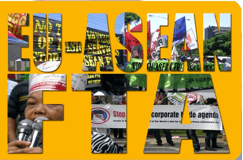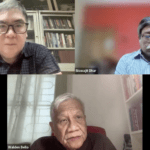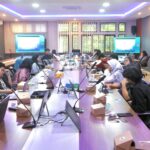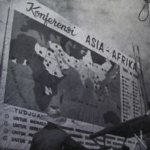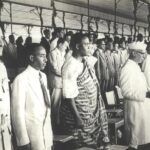Solidarity for Asian Peoples’ Advocacies (SAPA) Working Group on ASEAN
Analysis of the ASEAN Charter
When the Association of Southeast Asian Nations (ASEAN) announced that it will embark on a process of building a Charter to formalize its agreements and establish its legal framework, civil society groups paid attention. While ASEAN has been generally inaccessible and non-transparent, national and regional CSOs and social movements saw the strategic value of engaging the Charter process. We saw it as a space to stake claims on ASEAN and to demand accountability for its actions. We saw the Charter building process as an anchor for discussing ASEAN and generating interest on what the Association does. By engaging the process, CSOs and social movements hoped to pry open possibilities for transforming ASEAN into a rules-based organization that would work for the mutual benefit not only of ASEAN states but of ASEAN peoples and communities as well.
The Solidarity for Asian Peoples’ Advocacies (SAPA) Working Group on ASEAN invested time and energy to engage the ASEAN Charter building process. SAPA WG on ASEAN made three formal submissions to the Eminent Persons Group (EPG) – on the Political-Security Pillar (EPG consultation, Ubud, Bali/April 2006), on the Economic Pillar (EPG consultation, Singapore/June 2006), and on the Socio-Cultural Pillar and Institutional Mechanisms (Meeting with Ambassador Rosario Manalo, Special Adviser to Mr. Fidel V. Ramos, EPG Member for the Philippines, Manila/November 2006). The WG also participated in the only regional consultation held by the High Level Task Force (HLTF) on the drafting of the ASEAN Charter in March 2007 in Manila, and reiterated the main points of its submissions. Aside from the regional consultations that the SAPA WG on ASEAN worked hard to intervene in, the different network members also initiated national processes in 2006 and 2007 to help introduce ASEAN to civil society and inform them of the Charter that was being drafted.
The Charter drafting had been kept away from public access and scrutiny, making difficult any engagement in the process. The Charter will be signed on November 20th during the 13th Leaders Summit, but it was only on November 7th, when a copy of the final draft adopted by the High Level Task Force on the drafting of the ASEAN Charter was leaked to the media, that the Charter finally became known to the public.
The Charter is a disappointment. It is a document that falls short of what is needed to establish a “people-centered” and “people-empowered” ASEAN. It succeeds in codifying past ASEAN agreements, and consolidating the legal framework that would define the Association. However, it fails to put people at the center, much less empower them. The Charter is all about how Governments will interact with each other, but not about how they also should interact with the people. There are no clear spaces created or procedures established to institutionalize the role of citizens and civil society organizations in regional community-building. And where the Charter is able to protect sovereign interest of Governments, and enshrine confidence building though consensus, it lacks the necessary details for the settlement of disputes, dealing with internal conflicts, and disciplining or sanctioning Members who are remiss in their obligations.
The market-oriented language of the Charter expresses its bias for the economic project in the region, without recognition that this may be in conflict with the social and economic justice that the Charter is also supposed to uphold. The centrality of redistribution and economic solidarity to the goals of poverty eradication, social justice and lasting peace, is not acknowledged. Furthermore, the market orientation betrays the preference for a “one-size fits all” economic policy of trade and financial liberalization, failing to recognize the heterodox economic thinking that formed the basis of economic successes in the region in the past.
The Charter is gender blind and does not recognize the primacy of the regional environment.
Finally, the landmark inclusion of human rights in the Preamble and in the statement of Principles is belied by the lack of detail in the long-awaited human rights body.
Following are the SAPA WG on ASEAN’s specific comments on the Charter:
Preamble
-
The opening paragraph sets the tone for the entire Charter, highlighting the priority of the government over the individual citizen. A truly people-centered ASEAN should establish that governments are there to serve the needs and interests of citizens, and governments who fail in their duties and responsibilities should not be protected by ASEAN. A braver opening line should read, “WE, THE PEOPLES of ASEAN”, rather than “WE, THE PEOPLES of the Member States of ASEAN”.
-
Human rights are overarching and should form the basic principle of ASEAN from which all other principles flow. In this sense, human rights should be integral in all the work of ASEAN. Instead, human rights is placed low down on the list as a specific issue in Articles 1 and 2), and, symbolically, placed beneath the principles of sovereignty and non-interference.
-
While the Preamble and Chapter 1 uphold human rights and fundamental freedoms, the draft Charter only explicitly states adherence to the UN Charter, International Law and international humanitarian law, but does not explicitly recognize universally accepted human rights principles, including the Universal Declaration of Human Rights and recently signed international agreements that expand on human rights, norms and standards. The reference to adherence to the “rule of law, good governance and the principles of democracy and constitutional government” in Article 2h, however, may be a good handle to demand for the implementation of these principles in every member-state, especially in the case of Burma.
-
No mention is made of the role of ASEAN in the protection of the environment.
Chapters 1: Purposes and Principles
-
Article 1.5 and Article 2n, related to market and trade, are the most bothersome. These provisions explicitly talk only about “facilitating the movement of business persons and professionals”, “the free-flow of capital”, and “the elimination of all barriers to market-driven economy”, but do not provide at all for the promotion of redistributive justice, poverty eradication and growth with equity – ideals equally important to advance in a regional set-up, nor do they recognize social dialogue and core labor standards. These also fail to give importance to the role state instruments and cooperation in achieving social goals.
-
The same paragraph mentions the movement of “business persons, professional, talents, labour” but does not make explicit reference to migrant workers who make up a significant part of regional labor flows. There is also no reference to the movement of other people such as asylum seekers.
-
Article 1.7 qualifies the promotion and protection of human rights “with due regard to the rights and responsibilities of the Member States of ASEAN”. This wording is dangerous, because it undermines the fundamental elements of the universality and inalienability of human rights. It is not made clear what these “rights and responsibilities” of member states are, leaving the way open for governments to violate human rights in the pursuit of their self-defined “national interest”.
-
The provision on sustainable development, protection of the region’s environment and sustainability of natural resources in Article 1.9 was put in the same plane as the reference to “high quality of life of its people”, clearly reinforcing the dominance of the economic agenda of the ASEAN over environmentally sustainable development.
-
Most of the statements are mother/parenthood statements and much is left to further interpretation and how it is going to be concretely operationalized in the ASEAN. Does the language in Article 1.4 referring to “just, democratic, harmonious environment” and Article 1.11 on “…providing them with equitable access to opportunities for….justice” translate to agrarian reform/access and control over natural resources? Will the language in Article 9 on “sustainable development” mean the upliftment of the lives of small-scale farmers, fishers, and the rest of the rural poor and the promotion of sustainable agriculture and the non-promotion of the chemical intensive, bio-technology/GMO agriculture? Does Article 1.13 on “people-oriented ASEAN” include all sectors, including organizations of the rural and urban poor, as well as semi-skilled workers, including migrant workers?
-
While Article 1.13 states that participation of all peoples is encouraged, nowhere in the Chapter does it explicitly state how this will be actualized. The Charter does not create consultative and advisory mechanisms comprised of non-state actors and civil society groups, with adequate representation from all sectors. Neither does it create a mechanism for regularly engaging citizens within the region.
-
Article 1.14 needs to make specific reference to indigenous peoples, rather than simply referring to “diverse culture” which is too general.
-
Article 2.2e needs to establish that states also have a “responsibility to protect”, that is, the responsibility to protect people from gross violations of human rights. All ASEAN heads of state and government accepted this concept of the “responsibility to protect” at the UN World Summit in September 2005.
-
Article 2.2h/i makes no mention as to what happens, such as sanctions, if states do not adhere “to the rule of law, good governance, the principles of democracy and constitutional government” or “respect for fundamental freedoms, the promotion and protection of human rights, and the promotion of social justice.”
Chapter 3: Membership
-
The principle of non-interference (Preamble, Chapter 1, Article 2e/f) that characterizes the “ASEAN Way” is further reaffirmed in the Charter. However, we believe that exceptions must be made for clearly defined regional standards for state behavior, particularly on human rights and environment, serious breaches of which may carry ASEAN-imposed sanctions.
-
While on the whole we agree that there should be equality of rights and obligations among Members, there should also be a socializing factor whereby better resourced members are able to contribute to special funds to assist other members in the spirit of solidarity, cooperation, and regional redistribution.
Chapter 4: Organs
-
The Charter provides for the establishment of a human rights body, committing all member states to its creation. However, no further details are included regarding the setting up of the body, its roles and responsibilities, or the timeframe for its creation. Considering the more than a decade of work many sectors have put into the creation of an ASEAN human rights mechanism, the Charter should have had more details in it, and not run the risk of making this landmark provision inconsequential in operation.
-
There will be more meetings (of the ASEAN Leaders and the Foreign Ministers, and of the new organs created in the Charter), but it is unclear how these additional meetings and new organs will bring about a people-centered ASEAN. Almost all of the organs remain state- or government-oriented.
-
Article 15 redefines the role of the ASEAN Foundation as a collaborator with the different ASEAN bodies in support of “community-building’. It is only under this article that “civil society” is mentioned. This redefinition seems to imply that the ASEAN Foundation now becomes captured by purely official ASEAN agenda. Whereas before CSOs could apply for support without getting ASEAN accreditation or approval (and the ASEAN Secretariat sits only ex-officio in the Board), the ASEAN Foundation now becomes an internal entity to serve official ASEAN agenda.
-
In outlining the main decision making organs within ASEAN, there is not a single mention of engagement with citizens and civil society (except in the context of the ASEAN Foundation), or the means by which citizens and civil society can influence decisions and processes of the ASEAN.
-
Gender equality in the choice of officials in the ASEAN bodies is only mentioned under the provisions on the Secretary General, but is absent everywhere else.
Chapter 5: Entities Associated with ASEAN
-
Unfortunately we are unable to obtain a copy of the annexes, including Annex 2 which supposedly lists the entities associated with ASEAN. The expectation is that this is where citizens and civil society participation is institutionalized in the ASEAN, but even this is not certain. Like a few other bodies created in the Charter, the entities mentioned here are yet undefined, with rules and criteria for engagement still to be determined by the yet to be formed Committee of Permanent Representatives .
Chapter 7: Decision-Making
-
Chapter 7 still puts premium on consensus as the institutional and the preferred mode of decision-making. The affirmation of consultation and consensus actually encourages unanimity based on the least common denominator, and leaves much room for recalcitrant members to sabotage any consensus building processes around democratic values and the principles of the rule of law and good governance. Furthermore, to leave it to the ASEAN Summit to decide on a specific decision making process should consensus not be achieved allows for even greater leeway for political accommodation for which the ASEAN is historically known.
-
The Charter does not specify any space for citizens and civil society groups in policy-and decision-making, detracting from the essence of consultation and consensus-building by not affirming the people-centered principle of building regional identity through people’s participation.
-
Chapter 7 Article 21 leaves the prescription of each ASEAN Community Council’s rules of procedure to each council. There should be a mechanism to standardize the procedures for all councils.
Chapter 8: Settlement of Disputes
-
Disputes implied in the Charter only cover conflicts between and among ASEAN states, and do not address internal conflicts which are also significant in the region.
-
Except for disputes concerning economic agreements, for which the ASEAN Protocol for Enhanced Dispute Settlement Mechanism shall govern, the Charter provides for the establishment of dispute settlement mechanisms but for which no process or timeframe has been prescribed.
-
The issue of compliance is not addressed organically, except for cases to be referred to the ASEAN Summit for decision, limiting the efficacy of the to-be-established DSMs because the Summit by practice would yield to political exigencies.
-
The Charter does not recognize the need to establish conflict prevention and early warning mechanisms at the regional level with the involvement of citizens and civil society with demonstrated capacity to assist in conflict situations.
Chapter 9: Budget and Finance
-
Aside from provisions on “internal and external audit”, the Charter does not provide clear mechanisms for how the budget and finance of the Association can be made transparent and accessible to the public.
Chapter 10: Administration and Procedure
-
The ASEAN Charter does not mention how Chairmanship by countries whose leadership faces legitimacy questions shall be dealt with.
-
The choice of English as the working language of ASEAN, without reference to the use of regional languages for at least some purposes, leaves a big gap in terms of the need to promote national languages as a means to promote and protect the cultural heritage of the region.
-
The Charter does not provide for clear mechanisms for transparency and access to official information, and official processes, in the ASEAN.
Chapter 12: External Relations
-
Article 41.4 states that “in the conduct of external relations of ASEAN, Member States shall, on the basis of unity and solidarity, coordinate and Endeavour a common position and pursue joint actions”. This is a bold statement that affirms the centrality of ASEAN. Considering the less-than-unified positions espoused by individual Member Countries in multilateral fora (e.g. the WTO) in the past, it is interesting to know how the ASEAN would go about crafting common positions after the Charter is signed.
-
Consistent with the overall absence of the role of citizens and civil society in ASEAN, the Charter does not say anything about their role in helping ASEAN to develop and to determine its foreign policy, and in determining the status of external partners of ASEAN.
-
Considering the importance of migrant workers and their families in the conduct of ASEAN’s external relations, the absence of any mention about labor mobility as an issue to be discussed with external partners is glaring.
Chapter 13: General and Final Provisions
-
It is provided that the “Charter shall be subject to ratification by all ASEAN member states in accordance with their respective internal procedure”. This is short of what the Second and Third ASEAN Civil Society Conference (ACSC-II and III) called for, which is ratification by popular referendum.
-
The provision on Review (Article 50) only gives the requisite timeline (of five years after the Charter enters into force) but no clear procedures for its conduct, including who will be involved and how extensive such involvement would be.
The Solidarity for Asian Peoples’ Advocacies (SAPA) is an open platform for consultation, cooperation and coordination among and between Asian social movements and civil society organizations including NGOs, people organizations and trade unions who are engaged in action, advocacy and lobbying at the level of inter-governmental processes and organizations. SAPA aims to enhance cooperation among its members and partners to increase the impact and effectiveness of their engagement with inter-governmental bodies. Currently, there are four Working Groups in SAPA: Working Group on ASEAN (WG-ASEAN), Working Group on the UN Human Rights Mechanisms (WG-UNHR), Working Group on Migration and Labor (WG-ML), and Working Group on North East Asia (WG-NEA). There is also an Informal Caucus on South Asia.
The SAPA WG on ASEAN is a common platform for collective action on ASEAN advocacy. The WG-ASEAN respects and promotes the multiplicity of perspectives, strategies and forms employed by its individual members, as it strives for specific unities in ASEAN-related advocacy and action. Presently, the SAPA WG on ASEAN has more than 100 CSOs, national and regional organizations, as members.
Further information and documents related to SAPA and SAPA WG on ASEAN activities may be downloaded from http://www.asiasapa.org.
For more information, please contact the SAPA WG on ASEAN Focal Points:
Corinna Lopa, Southeast Asian Committee for Advocacy, [email protected], +63-928-5025685
Anselmo Lee, FORUM-ASIA, [email protected], +66-81-8689178
For more information on the SAPA WG on ASEAN’s engagement of the ASEAN Charter process, please contact:
Jenina Joy Chavez, Focus on the Global South, [email protected], +63-918-9016716
Alexander Chandra, Institute of Global Justice, [email protected], +62-817-790440

